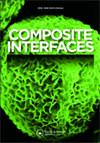载荷下热爆炸连接钢支架的复合tic - ni基复合材料:合成、显微组织和摩擦学行为
IF 2.4
4区 材料科学
Q3 MATERIALS SCIENCE, COMPOSITES
引用次数: 0
摘要
摘要利用ti - ni -石墨(碳化物、硼化物、氧化物)反应混合物在载荷作用下的热爆炸燃烧方式,制备了复合材料,并将其致密化并连接到C55碳钢支架上。在1373 K的等温保持360秒后,由于绿色致密体的快速高频加热达到1573 K,进行了放热反应的点火。该工艺保证了复合材料与钢基体之间完美的机械装配。在界面处进行的SEM分析和浓度谱证实了两种材料之间铁和钛原子的相互扩散。最高燃烧温度(Tmax)超过2200 K时,形成有利于致密化和接合的液相,其中一部分添加剂在冷却前溶解。反应混合物的初始化学成分在很大程度上决定了加工后复合材料的显微组织、硬度和摩擦学性能。因此,含TiC、Al2O3和TiB2硬相的试样硬度最高(1235 HV0.15),磨损率最低(1.824 × 10−6 mm3.N−1.m−1)。无论起始成分如何,所制备的样品均不会因剥落而导致复合材料的劣化。关键词:热爆炸复合材料连接显微结构检索行为披露声明作者未报告潜在利益冲突。本文章由计算机程序翻译,如有差异,请以英文原文为准。
Complex TiC-Ni-based composites joined to steel support by thermal explosion under load: synthesis, microstructure and tribological behavior
ABSTRACTThe combustion in thermal explosion mode of reactive mixtures of Ti–Ni–graphite(carbides, borides, oxides), under load, was used to produce complex composite materials, densified and joined to a C55 carbon steel support. The ignition of the exothermic reaction, carried out thanks to the rapid high-frequency heating of a green compact up to 1573 K, was followed by an isothermal holding at 1373 K for 360 s. This procedure ensured a perfect mechanical assembly between the composite material and the steel substrate. SEM analysis and concentration profiles carried out at the interface testified to the interdiffusion of iron and titanium atoms between the two materials. The maximum combustion temperature (Tmax.) exceeding 2200 K induced the appearance of a liquid phase that assisted densification and joining, and in which a part of the additions was dissolved before cooling. The starting chemical composition of reactive mixtures largely determined the microstructure, hardness and tribological behavior of the composites after the process. Thereby, the maximum hardness (1235 HV0.15) and the lowest wear rate (1.824 × 10−6 mm3.N−1.m−1) were obtained in the sample containing TiC, Al2O3 and TiB2 hard phases. The manufactured samples exhibit no deterioration of the composite by spalling, regardless of the starting composition.KEYWORDS: Thermal explosioncomplex compositesjoiningmicrostructuretribological behavior Disclosure statementNo potential conflict of interest was reported by the author(s).
求助全文
通过发布文献求助,成功后即可免费获取论文全文。
去求助
来源期刊

Composite Interfaces
工程技术-材料科学:复合
CiteScore
5.00
自引率
3.80%
发文量
58
审稿时长
3 months
期刊介绍:
Composite Interfaces publishes interdisciplinary scientific and engineering research articles on composite interfaces/interphases and their related phenomena. Presenting new concepts for the fundamental understanding of composite interface study, the journal balances interest in chemistry, physical properties, mechanical properties, molecular structures, characterization techniques and theories.
Composite Interfaces covers a wide range of topics including - but not restricted to:
-surface treatment of reinforcing fibers and fillers-
effect of interface structure on mechanical properties, physical properties, curing and rheology-
coupling agents-
synthesis of matrices designed to promote adhesion-
molecular and atomic characterization of interfaces-
interfacial morphology-
dynamic mechanical study of interphases-
interfacial compatibilization-
adsorption-
tribology-
composites with organic, inorganic and metallic materials-
composites applied to aerospace, automotive, appliances, electronics, construction, marine, optical and biomedical fields
 求助内容:
求助内容: 应助结果提醒方式:
应助结果提醒方式:


